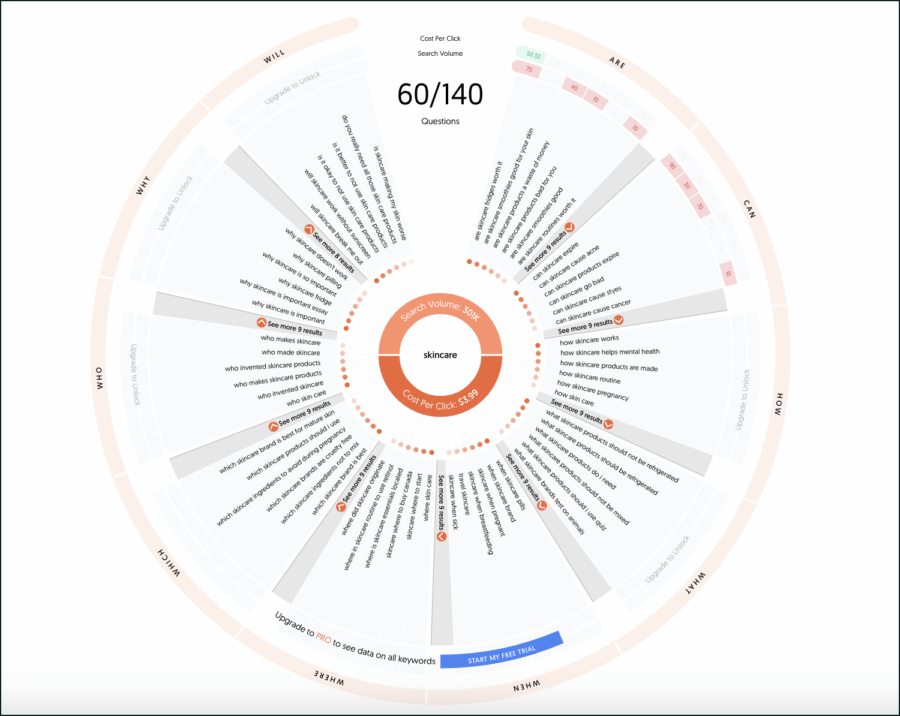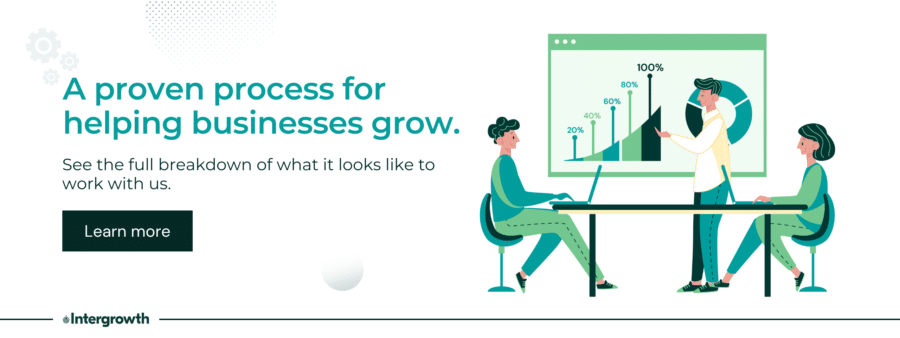Although the content marketing landscape is changing, one thing remains the same:
Your audience wants authenticity and information they can trust.
It’s our job as content marketers to provide that.
Good content can help you show off your expertise, build awareness around your brand, and generate more leads so you can grow your business.
This article dives into the why and the how of content development to help you build a content marketing strategy that works.
What Is Content Development?
Content development is the end-to-end process of creating content for a website. Content, in this instance, can be anything from blog posts and case studies to infographics, videos, and podcasts.
Content development includes:
- Content strategy
- Creation
- Optimizing for search engines (SEO)
- Publishing
- Promotion
We’ll explain each of these steps in detail below as we walk through the content development process we’ve built over the years — and the one that we use to help grow our clients’ businesses.
We are excited to share what we’ve learned so that you can jumpstart your own content marketing efforts.
1. Gather Information
The first step in content development is always to collect as much information as possible.
When we’re working with companies, we compile information on:
- Target demographics
- Key competitors
- Business goals
- Other information unique to the individual client
The best way to collect this information is to ask your customers directly. If you’re developing content for your own business, put together a mock interview document and answer the questions yourself. The answers might uncover information that will make for great blog posts.
Here are some questions that we ask every client:
- What problems do you help your customers solve?
- What do you offer that your competitors don’t? (Dig deep on this one)
- What search phrases do you want to rank at the top of Google for? (Use this to find variants and related topics!)
- What are the most common questions prospects ask you before converting?
Next, assess the performance of your competitors’ content and your past content marketing efforts.
Google Analytics and Search Console are great tools for analyzing your website’s performance. SEMRush is our go-to tool for competitor analysis. And it’s hard to beat Ahrefs when it comes to keyword research and backlink analysis.
Taking the time to analyze the above will help you make informed decisions about what topics to cover.
See also: These 13 SEO Tools Can Help You Develop Content
2. Blog Topic Analysis
There are a few ways to come up with topics to write about.
To start, we’re going to look at our competitors’ content, target audience searches, and semantically related search terms.
Competitor Analysis
Optimizing your content for search engines gives you the opportunity to literally “get in front of” your competitors so that customers who are researching products go to your website before competing websites.
Even if you’re competing against big, powerful companies, you can still outperform them in certain searches.
It can take time to outrank big names, and it can be impossible for certain keywords. But, the opportunity lies in outranking them for more specific, niche terms.
For instance, let’s say you want to write a guide about how to start a clothing brand. You probably won’t be able to rank at the top of Google for the term “how to start a clothing brand” because Shopify, BigCommerce, and NerdWallet (all established giants) already appear in the first three spots.
However, you may be able to rank for a term like “how to start a clothing brand with no experience.” It doesn’t get quite as many searches as the former keyword, but you have a much more realistic chance of ranking at the top of Google (and, therefore, of people actually finding your article in search engines).
The easiest way to run this type of competitor analysis is to use Ahrefs. Their Content Gap tool allows you to plug in your domain and up to three of your competitors’ domains, and then tells you which keywords your competitors are ranking for that your site isn’t.

If you’re not ready to invest in SEO tools yet, that’s okay; just type a target term into Google, look at the top 3 results, and ask yourself:
Could I write a better, more informative article than the articles that currently rank at the top?
If your answer is yes, give it a shot.
Topic Analysis and Keyword Research
Another way to find blog articles is to plug your primary keywords (i.e., the most important keywords you want your business to rank for) into a tool like AnswerThePublic.
For example, let’s say you sell skincare products. Your ultimate goal, as far as SEO, is to appear at the top of Google when people search the term “skincare” or “skincare products.”
(Again, this will likely take a long time.)
If you plug the term “skincare” into AnswerThePublic (or an alternative like Keywords Everywhere), you’ll get a big list of popular searches that include this word, like this:

Clicking any of those generated keyword phrases will send you directly to Google, where you can see if anyone has provided a good resource on that topic.
Even better, you can export the list of questions, plug them into Ahrefs, and use Ahrefs’ data (specifically search volumes and keyword difficulty scores) to identify the best opportunities.
As you publish more content around the topic of skincare, Google will start to see that you’re a skincare expert, and you’ll be able to rank for more competitive terms.
3. Strategize
During this phase of content development, we build out the content strategy and editorial calendar.
Starting out, my recommendation is to publish at least two long-form blog articles per month on broad topics with viral potential (viral within your industry, of course).
At Intergrowth®, we call this type of content Awareness Content because its primary goal is to make people aware of your business. Awareness Content typically targets keywords that are relatively easy to rank for but relate to your business. It brings people to your website who may be interested in your products but are, at the very least, interested in topics related to your industry.
Awareness Content is very important, but it doesn’t usually drive direct sales.
For example, we have an article on our blog titled 45 Mind-Bottling SEO Statistics that has been very effective at building awareness around our brand. If you run a skincare company, an article like How Are Skincare Products Made could be a good piece of Awareness Content. It probably won’t convert as many customers as other pages on your website, but it could potentially see a lot of traffic.
A good content strategy also includes two other types of content:
- Sales Centric Content, which is content that aims to convert leads into customers (ex. competitor comparisons)
- Thought Leadership Content, which showcases the unique ideas and opinions you’ve developed from years of working in your industry (e.g., controversial takes, industry predictions, etc).
Again, I suggest focusing on Awareness content for the first 3-4 months, as it can help you to quickly scale your organic traffic.
Backlinks Are Crucial to a Content Strategy, Too
Backlinks are links that point back to your content from another website. Google uses backlinks to assess a website’s reputation; websites with a lot of backlinks from high-profile websites are usually rewarded with higher rankings.
We build backlinks to all of the content we create for clients in order to help get it on Google’s radar. Depending on the client’s goals, we might build additional links to maximize its visibility.
If you’re managing your own content strategy, consider using Connectively (formerly HARO) or other link-building tactics to build some backlinks to your homepage or content page.
4. Write
The writing stage is pretty self-explanatory. Here is where you write the best piece of content possible.
Again, if you want to rank well, your content needs to be better than every other result on the front page of Google.
That used to mean the longer, the better. Longer content ranked better and attracted more backlinks because it was usually more informative and covered more related topics.
To an extent, that is still true as it concerns information-heavy topics. However, Google’s recent algorithm updates appear to favor content that answers a question fully but succinctly.
That means an Awareness Content article should give the reader the overview first and then go into detail to answer related essential questions — as necessary. You don’t need to mention how to clean every part of a blender for a “how to make a margarita” search query.
Tip: Try not to focus on keywords or other ranking signifiers during the writing stage. Remember, you want people to read and enjoy the content first and foremost. Search engines should be an afterthought during the writing process.
Put yourself in the reader’s shoes. Think about why they would search for a topic and what they would want to read in response to that search query. Then, produce a piece of high-quality content that satisfies search intent and that will entice the reader to share.
If you’re new to blogging, read this guide on how to write your first blog post.
5. Optimize & Publish
Once the writing phase is complete, we move on to SEO and publishing.
It’s here that we consider things like readability, word count, semantic keywords, and brand consistency to make the content more attractive to readers (and search engines).
If you really want to go down the rabbit hole, learn about TF-IDF, one of our favorite optimization methodologies. It sounds complicated, but it’s super effective in helping Google understand that you’ve covered all of the subtopics relevant to your main topic.
During the optimization and publishing phase, we’ll also craft title tags and meta descriptions designed to increase click-through rates.
For more super actionable optimization tips, check out this list of SEO techniques to boost rankings.
6. Promote
There are hundreds of ways to promote quality content, but the most obvious are social media and email (i.e., promoting your content in a newsletter).
Promotion doesn’t just to get more eyes on the article; it can also lead to more backlinks, which, again, can improve your search engine rankings.
That said, never pay for backlinks. It’s not worth it, and you will get hit with a Google penalty (which means your site may not appear in Google searches, or at least won’t appear in a favorable spot).
7. Review & Repeat
Content development is never “done .” It’s a continuous process that starts as soon as it ends. That’s why we review our content marketing efforts for every website on a monthly basis.
If our efforts are working, we’ll continue down the same path for future content. If we do not see results, it’s time to pivot to a new content development strategy.
If you’re not sure what to analyze, dive into this guide to analyzing your marketing strategy.
Essentially, during this phase, it’s time to reflect on what worked and what didn’t, putting us back at the “Gather Information” phase of the process.
The main takeaway here is that the best content development process is continuous and ever-changing. It’s not something you can do once and say you’re done.
Takeaway: Our 7-Step Content Development Process
- Gather Information
- Blog Topic Analysis
- Strategize
- Write
- Optimize & Publish
- Promote
- Review & Repeat
Ready to kickstart your content development efforts? Get in touch about our content marketing and SEO services.
SCALE YOUR ORGANIC TRAFFIC
Subscribe to our monthly newsletter





